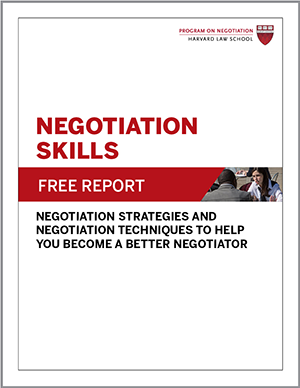
Because of the anchoring bias, opening offers have a strong effect on negotiation. The first offer made in a negotiation serves as an anchor that influences the discussion that follows, even when that anchor is extreme. Consequently, abundant negotiation research suggests that you should try to make the first offer, unless the other party knows much more than you do about the value of the item being negotiated or about relevant market or industry conditions. Your opening offer should be aggressive but not absurdly so, recommends Columbia Business School professor Adam D. Galinsky based on his research.
For example, suppose you are about to negotiate the price of your used car with a potential buyer. You know that the fair market value of the car is about $5,000–$6,000. You want to make an opening offer that is aggressive but not offensive. Should you name a specific price—say, $7,000—or suggest a price range, such as “I could sell the car to you for about $6,500 to $7,500”?
If you were to follow the most common negotiation advice, you would stick with a single figure, such as $7,000, rather than expressing your offer as a range. In the past, experts have warned negotiators not to make so-called range offers. Why? They predict that your counterpart will attend only to the endpoint of your range that favors him and negotiate from there. For example, if you offer $6,500–$7,500, the potential buyer might focus on $6,500 and negotiate downward, ignoring the $7,500 endpoint. Because a range offer is at best pointless and at worst harmful, the thinking goes, it’s better to start off with a single figure (such as $7,000).
That’s the conventional wisdom, but, interestingly, this idea is not extensively tested by negotiation researchers. In one study, however, in the Journal of Personality and Social Psychology, Columbia University professors Daniel R. Ames and Malia F. Mason find that, rather than being a money-losing strategy, expressing offers in a range—when done with care—can be an often-overlooked means of claiming more value for yourself in financial negotiations.
How the anchoring bias works with a range offer
Turning to the question of whether a single figure or a range offers a more advantageous anchoring bias, Ames and Mason suggest that “when it comes to first offers, two figures have the potential to be more potent anchors than one.” That is, contrary to the theory that a party presented with a range offer will notice only the endpoint that serves her interests, the researchers posit that both endpoints in a range offer will shape the other side’s perceptions of what constitutes a reasonable or feasible outcome.
When expressing offers, negotiators tend to use three different types of ranges relative to the single-figure offer they might otherwise make, such as $7,000 for the car.
As you can see, the three types of ranges vary in their ambition:
1. Bolstering range: A bolstering range includes the single-figure offer at one end and a more ambitious number at the other end, such as a seller asking $7,000–$7,500 rather than $7,000 for her car.
2. Backdown range: A backdown range features the single-figure offer at one end and a less ambitious figure at the other end, such as the same seller asking $6,500–$7,000 for her car instead of $7,000.
3. Bracketing range: A bracketing range spans the single-figure offer, such as an offer of $6,800–$7,200 rather than $7,000 for the same car.
In a pilot study, Ames and Mason examined the types of ranges people gravitate toward in price negotiations. They asked nearly 400 U.S. participants to imagine that they were the seller in a used-car negotiation and to come up with both a single-figure offer and a range offer for the car. Of participants, 51% constructed bracketing-range offers, 29% constructed backdown-range offers, and only 17% constructed bolstering-range offers. These results hint at why range offers are often deemed ineffective. If most people construct unambitious bracketing and backdown ranges that are no more aggressive or less aggressive than the single-figure offers they would otherwise make, it’s not surprising that range offers would lead to disappointing outcomes.
Why it pays to bolster
By contrast, Ames and Mason found across five experiments that bolstering ranges—those that aggressively stretch the bounds of a single-figure offer—can be highly effective in price-haggling negotiations. In one experiment, which was conducted online, participants were assigned the role of either buyer or seller of a used car. Those playing the seller were randomly assigned to four conditions and asked to make one of the following types of opening offers: (1) a single-figure offer, (2) a bracketing-range offer, (3) a bolstering-range offer, or (4) a single-figure offer more ambitious than the one that first came to mind. This fourth condition was designed to determine whether it would be better to make a bolstering-range offer or to “bump up” the single-point offer to the figure at the more ambitious end of the bolstering-range offer.
The pairs of buyers and sellers then engaged in a simulated negotiation in an online chat room. Consistent with the results of Ames and Mason’s other experiments, buyers who received bolstering-range offers made greater concessions and more conciliatory counteroffers than did buyers who received the other types of offers. Why? Because of the anchoring bias, they assumed that their sellers had more ambitious bottom lines (or reservation prices).
In addition, buyers faced with bolstering-range offers were more concerned than buyers who received a single-figure offer that their counterpart would perceive them as impolite if they made an assertive counteroffer. The researchers theorized that a range offer, such as $7,200–$7,500, signals greater flexibility than a single-price offer, such as $7,200. “Whereas rejecting a point offer may be the norm in many bargaining situations, responding to a range offer with a value well outside the range may feel like an affront, an overly harsh reaction to an apparent show of flexibility,” write Ames and Mason. Consequently, recipients of range offers may be at pains to counter within the suggested range, a tendency that may work to your advantage when you present a bolstering range.
Interestingly, the results showed that “bump-up” offers—those that participants bumped up to a more ambitious single figure from their initial offer—did not yield better final agreements and were far more likely to lead to impasse than other types of offers, including bolstering-range offers. Thus, a bolstering range that ends with an ambitious target (such as $7,500–$8,000) may be more effective than simply offering the ambitious target ($8,000) on its own.
Using the anchoring bias as a tool for better outcomes
Bolstering-range offers not only appear to lead to better outcomes in single-issue negotiations but also those who make them seem to avoid the reputational damage that often accompanies aggressive offers, Ames and Mason found in their experiments. Because ranges appear to convey flexibility and accommodation, they may offset the assertiveness conveyed by asking for more.
There are limitations to the effectiveness of bolstering-range offers, however. First, as you might expect, very wide ranges (such as $6,000–$9,000 for a used car as compared with $6,000–$7,000) did not yield significant gains as compared with more standard ranges in these experiments. Ranges of about 5% to 20% of the base figure appear to work best. In addition, bolstering ranges that started with an extreme value and extended to an even more aggressive figure (such as $8,000–$9,000 rather than $7,000–$8,000 for that used car valued at $6,000) also were not beneficial.
Overall, the research leads to the conclusion that in single-issue negotiations, range offers are not always the misguided trap that experts have long believed them to be. Ames and Mason end their study with the following advice:
Backdown ranges are counterproductive and should be avoided.
Bracketing ranges, which can enhance relationships, may be useful when you are particularly concerned about appearing fair-minded and nonaggressive.
When crafted carefully, bolstering ranges can help you claim the most value without sacrificing the relationship or your reputation.
Bolstering women’s results
Bolstering-range offers may be particularly useful to women. In their research, Hannah Riley Bowles of the Harvard Kennedy School, Linda Babcock of Carnegie Mellon University, and Lei Lai of Tulane University found that men were less inclined to work with women who initiated negotiations for higher compensation than with women who did not ask for more. Further research is needed, but the fact that Daniel R. Ames and Malia F. Mason found in their study that negotiators who use bolstering ranges gain more for themselves and protect their relationship with the other party suggests that such offers may help women avoid the social backlash triggered by assertive negotiating behavior.
How have you found the anchoring bias to work in your negotiations? Does a range offer result in better outcomes?





